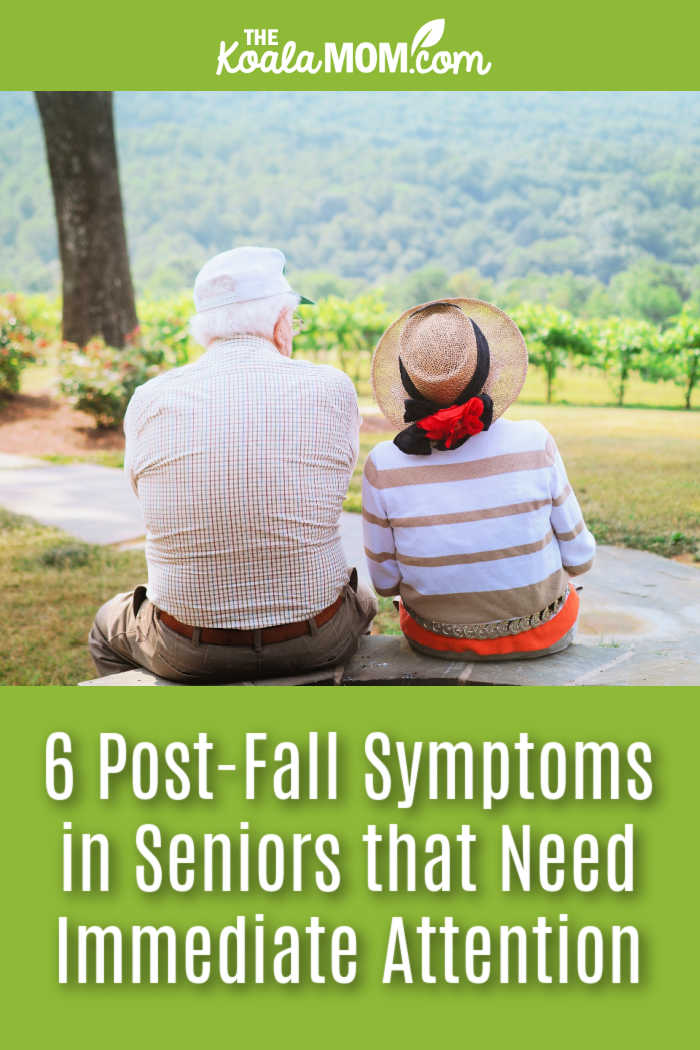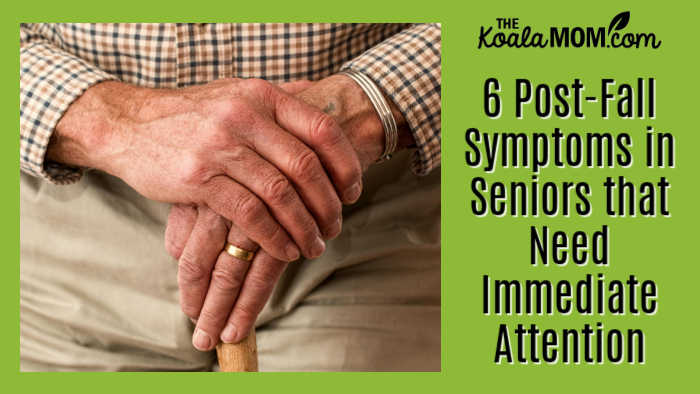Falls among seniors can result in serious injuries and complications. As individuals age, the likelihood of experiencing a fall increases due to factors such as weakened muscles, deteriorating balance, or certain medications. It is essential to recognize that not all symptoms will be immediately apparent after a fall. Some may take time to manifest, which makes it crucial for caregivers and family members to monitor seniors closely for post-fall symptoms.
Understanding what to watch for can ensure timely medical intervention, helping to prevent more severe outcomes and possibly save a life by providing early care.

Although I have not personally been a caregiver to any of my elderly loved ones, I have seen the repercussions of their falls. My great-aunt was very fragile and living in an assisted care facility when she fell and broke her hip; I had the chance to visit her in Ontario during her lengthy hospital stay, before she passed away. My grandmother was out getting groceries one winter day by herself when she fell and then walked home afterward. Unfortunately, her dementia was already so bad that she could tell us nothing about the fall, but it did make her more cautious, and helped the family to know that she shouldn’t be allowed to grocery shop on her own any more.
Unexplained Pain
Immediately following a fall, a senior may express discomfort or pain in areas that seem unaffected by the fall itself. Unexplained pain can be a warning sign of serious underlying issues such as fractures, internal injuries, or organ damage. It is important to assess where the pain is concentrated, as regions that are not visibly injured may still have internal damage that requires immediate attention from a medical professional.
Pain that emerges several days after the fall should also not be overlooked, as it can indicate complications that could worsen over time if left untreated. Early intervention can prevent further injury and lead to better recovery outcomes.
Blood Loss or Hematomas
An observable sign that something is amiss post-fall could be blood loss. Seniors might experience bleeding from a cut or laceration sustained during the fall. However, more insidious forms of blood loss can occur internally. Hematomas, or localized pooling of blood outside of blood vessels, can manifest as discolorations on the skin.
As bruising often indicates that blood vessels have burst, caregivers should learn to recognize these signs and look for bruising around areas that might not have made contact with the ground but are adjacent to any injury. Internal bleeding, if not addressed quickly, may lead to severe complications, necessitating urgent care.
Dizziness or Confusion
Dizziness or confusion following a fall can often be alarming. These symptoms may indicate a concussion or other traumatic brain injury that can occur even in minor falls. Seniors who become disoriented or struggle to maintain balance after a fall need immediate medical evaluation. It’s critical to understand that some seniors might display cognitive disruptions like confusion, which could signal head trauma requiring prompt medical assessment. Performing a thorough cognitive evaluation can determine if any neurological interventions are necessary.
My grandfather fell after being hit by a truck while grocery shopping. He was able to talk clearly to the emergency personnel who helped him immediately after the accident, so they sent him home. However, at that time, he was living on his own. Confusion developed later and lead to my uncle taking my grandfather back to the hospital. I still feel that, due to the cause of my grandfather’s fall, he should have been kept at the hospital for observation and may have received additional care sooner than he did, and may have recovered from that accident.
Changes in Mobility
Any alteration in a senior’s ability to move after a fall is significant. If an individual who was previously mobile develops difficulty walking or standing, this should raise alarms. Sometimes, a senior might adopt a protective stance to avoid further pain, leading to a posture that is atypical for them. Changes in mobility can signal various issues, including fractures, dislocation, or even soft tissue injuries. Immediate assessment of the individual’s capacity to move freely or engage in daily activities can help medical professionals diagnose the severity of injuries.
Behavioral Changes
Post-fall behavioral changes in seniors can be quite subtle but equally concerning. An otherwise cheerful and independent senior may display anxiety, depression, or withdrawal following a fall. These psychological shifts should not be underestimated, as they can indicate underlying pain or fear of falling again. My great-aunt dealt with severe depression in the hospital after breaking her hip. Unfortunately, visiting hours were only two hours a day then, so I felt helpless in any way to help her and have always wondered if her mental struggles contributed to her physical decline.
Observing these changes can help caregivers understand the emotional impact of the fall, allowing them to seek prompt mental health intervention if appropriate. Addressing these emotional concerns can play a crucial role in the overall recovery process, ensuring the senior can regain confidence and functionality following their injury.
Incontinence or Difficulty with Normal Activities
The inability to control urination or defecation, also known as incontinence, can be a serious sign of distress following a fall. This symptom may indicate significant bodily trauma, particularly to the pelvic region, hips, or spinal cord. If the senior starts experiencing difficulties with activities like dressing, bathing, preparing meals, or other daily functions that were previously manageable, it may signal a decline in their physical capability due to injury.
Any significant deviation from their usual level of independence or a sudden onset of new physical challenges necessitates a thorough medical examination. These changes can often signify more serious health issues, which, if identified and treated swiftly, can lead to more effective recovery outcomes and an improved quality of life for the elderly population.

All these factors can signify undercurrents of more serious health issues which, if identified and treated swiftly, can lead to more effective recovery outcomes for the elderly population. Recognizing the signs and symptoms following a fall in seniors can ensure their safety and health. Prompt assessment and treatment can greatly reduce the risks associated with falls, reinforcing the importance of vigilance and proactive care. Regular check-ups and open communication between seniors, caregivers, and healthcare professionals are instrumental in maintaining an improved quality of life as they age.

No Responses Yet